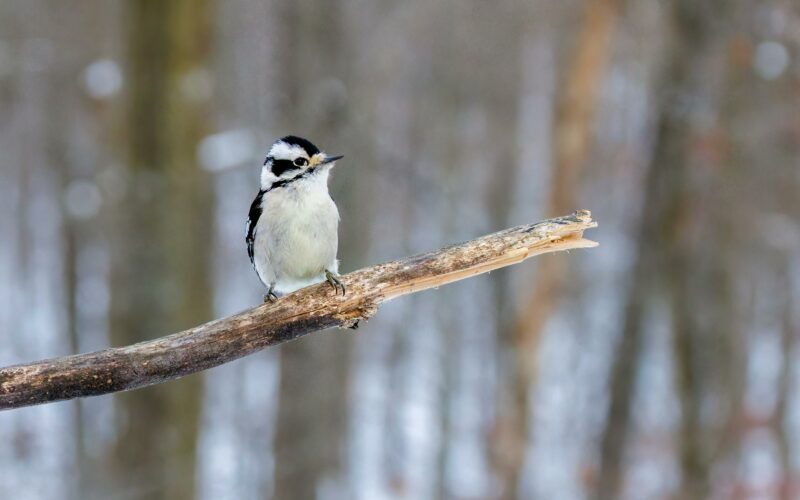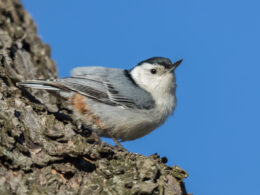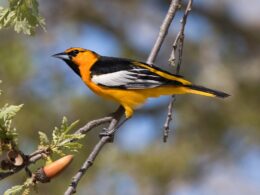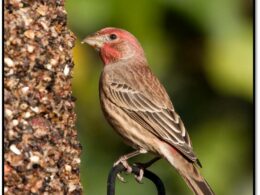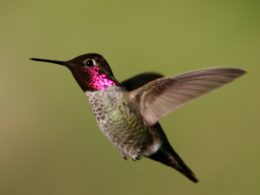Last Updated on January 19, 2024 by Greg Gillson
Feeding birds in winter can be a very enjoyable activity. If you are wondering how to get started feeding birds in winter in New York, this article is for you!
This article tells all about how and why to set up a winter bird feeder in New York. It also tells you some of the birds you can expect in your backyard and how to attract them to your feeder.
Winters in most of New York are cold. Winter average temperatures drop to below freezing often at night. In the southeastern part of the state, near New York City, temperatures are milder, but still still cold. Snowfall varies throughout the state, but even in the warmer southeast near the ocean, snowfall in winter is expected regularly.
So it can be challenging for birds to find food at times in winter in New York. That’s where your backyard feeder can really help!
Why feed winter birds in New York?
Severe weather can make it difficult for birds to find their daily needs of food and water. Your feeding birds in your backyard can really make a difference during freezing periods or heavy snowfall.
Warmer weather in the southern part of the state near the Atlantic Ocean means that more birds spend the winter there–species that may not be as hardy as birds regular inland and northward. These birds may not survive a prolonged cold period. A backyard bird feeder can make the difference between life and death for some of these birds.
In fact, many birds have extended their winter ranges northward in recent decades because they are able to find food at backyard feeders.
Birds in their first year are less experienced at finding food. By late winter it is harder to find seeds and fruit and berries. They’ve mostly been eaten. And insects by be nearly absent, too. So these younger birds stick close to any bird feeders or other sources of food–especially if the yard is landscaped with dense bushes that provide cover or other sources of food.
When the weather is dreary, you an I get immense joy out of watching birds at our feeders. It is actually good for our mental health to watch the antics of these hyperactive and colorful creatures. We actually get a feeling of ownership or responsibility. When the feeders are empty, we say we have to go out and feed “our” birds!
Feeding birds in winter often leads to feeding birds all year long. And there’s nothing wrong with that, either.
What birds come to feeders in New York in winter?
New York has an abundance of birds that visit feeders in winter. Following are photos and descriptions of some of the most frequent feeder visitors. There are many more birds that may be found in your backyard throughout the year. Please read my related article on common backyard birds of New York.
The summaries below list basic identification, voice descriptions, and what foods you may offer to attract each species. It also tells what kind of feeder each type of bird likes to eat from.
Black-capped Chickadee
This friendly little bird sports gray back, wings, and tail. It has a black cap and throat contrasting with a white face. The under parts are buffy. The round head has a short and stout bill. The tail is long and rounded.
 |
| Black-capped Chickadee Photo by Greg Gillson |
These birds are found in deciduous woods and backyards throughout the northern parts of the United States, Canada, and Alaska.
In New York, Black-capped Chickadees winter throughout the state.
They give a chick-a-dee-dee call and a whistled song fee-bee-bee.
Black-capped Chickadees love black oil sunflower seeds. They eat from any kind of bird feeder. They also eat suet.
Dark-eyed Junco
These small sparrows are frequently called “snowbirds” because flocks of these tiny birds show up at bird feeders in winter.
 |
| Dark-eyed Junco Photo by Greg Gillson |
They breed in conifer and mixed woods across northern United States, Canada, Alaska, and mountains of the West and Northeast.
In New York, Dark-eyed Juncos can be found throughout the year, except in the south and coastal areas where they are winter visitors only, for the most part.
These birds are quite varied in their appearance. In the East they are slate-gray above, including a hood, with a white belly. They flash white outer tail feathers as they feed on the ground. The bill is short and conical, colored pink or whitish.
They have twittering calls and in spring a long musical chipping song on one pitch.
Dark-eyed Juncos like smaller seeds, especially white proso millet. They like to feed on the ground or on platform feeders where they can hop around and scratch at the ground.
White-breasted Nuthatch
Often seen in pairs, these small birds crawl over, around, and down tree branches and trunks.
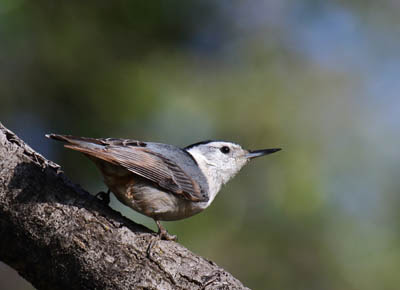 |
| White-breasted Nuthatch Photo by Greg Gillson |
They are found in woodlands across the United States and southern Canada. They prefer deciduous forests in the East, oaks and pines in the West.
White-breasted Nuthatches are resident throughout New York.
Plump with a short tail, they have a blue-gray back and darker wings. The under parts and face is white with a black crown stripe from bill to back. The bill is long and chisel-shaped.
Birds give a nasal yank yank call.
White-breasted Nuthatches come to feeders to eat black oil sunflower seeds and feed on suet. They will eat at any type of seed feeder.
Northern Cardinal
This fairly large songbird is a year-round resident where it occurs.
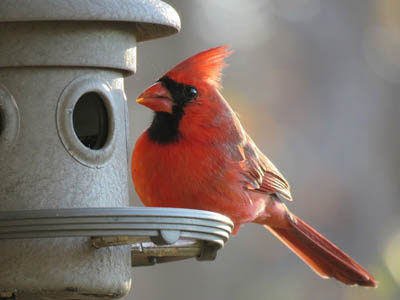 |
| Northern Cardinal Image by GeorgeB2 from Pixabay |
They like deciduous woodlands and open spaces across the eastern half of the United States.
They can be found throughout New York State, but are scarce in the Adirondack Mountains in the northeastern part of the state.
Males and females have a large orange conical beak and crest. Males are bright red with a black face. Females are duller pale brown with some reddish tones.
They sing throughout the year a loud and varied whistle: cheer cheer cheer and birdy birdy birdy. They also have a sharp chip call.
Northern Cardinals prefer a bit larger seeds than some other feeder birds. They eat all types of sunflower seeds and safflower seeds. The eat from platform and larger hopper feeders.
Red-bellied Woodpecker
This medium-sized woodpecker is fairly common in backyards, parks, and open woodlands across the eastern half of the United States.
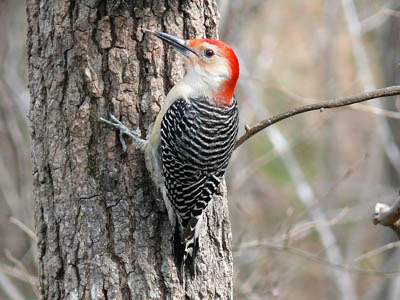 |
| Red-bellied Woodpecker Image by skeeze from Pixabay |
In New York Red-bellied Woodpeckers are resident year-round away from the higher mountains.
Birds are grayish on the under parts and head, but with a red nape. The back is barred throughout with thin black and white bars. They have strong legs and a short tail that they use to prop themselves against the tree trunk and hitch their way upwards as the look for food. Males have more extensive red crown and a pink blush on the belly.
Call is a rolling churr.
Red-bellied Woodpeckers visit platform feeders. They like sunflower seeds and peanuts. They love suet, too.
American Goldfinch
These tiny birds are almost always found in small flocks–especially in winter.
 |
| American Goldfinch Photo by Greg Gillson |
They are found throughout the year in grasslands and open spaces across the northern United States. In summer they also move into southern Canada to breed. In winter, northern birds move south to be found in all of the southern United States, as well.
American Goldfinches are found throughout the year in all of New York.
Males in summer are bright yellow with black and white wings and tail. However, in winter all birds are quite dull tan with yellow throat. The black wings and broad pale wing markings are always obvious.
The bill is small and conical. The tail is rather short and strongly forked.
Calls include a four-part per-chick-o-ree or po-ta-to-chip flight note as they fly overhead.
American Goldfinches love Niger seed from special thistle feeders. They also eat black oil sunflower seeds from tube feeders. But, even more, they prefer hulled sunflower seeds to those with the shell still on.
White-throated Sparrow
Found in brushy woodlands, they are mostly found in summer in Canada. In winter they migrate to the eastern and southeastern United States.
 |
| White-throated Sparrow Photo by Greg Gillson |
In New York, White-throated Sparrows are right on the edge of their resident territory. They can be found year-round in most lowland interior areas. In summer they breed up into the mountains. In winter they move down to Long Island and the southern part of the state where they are absent in summer.
They are a bigger sparrow, smudgy brown below with a gray breast and contrasting white throat. Tail and wings are brown with two thin wing bars. The back is striped tan and dark brown. The center of the crown has a white stripe, there is a thin dark lateral crown stripe, and a wide white or buff eyebrow stripe. There is a yellow spot in front of the eye. The bill is gray and conical shaped.
The bird sings a loud whistled phrase of 4 or 5 notes: Oh Canada or Ole Sam Peabody.
White-throated Sparrows may feed on a variety of seeds, including sunflower seeds and white proso millet, from a platform feeder or on the ground.
Mourning Dove
These may be the largest birds normally found in your backyard feeders.
 |
| Mourning Dove Photo by Greg Gillson |
They are widespread in residential and agricultural lands, and open woods. In summer they are found across southern Canada, the United States, and much of Mexico. In winter they withdraw from most of Canada and the Great Plains.
In New York, Mourning Doves are resident in the south and summer visitors to the northern mountain areas.
Plump and tan or pinkish, they have a small round head and long pointed tail.
They give a mournful cooing song.
Mourning Doves eat white proso millet, cracked corn, and a wide variety of seeds and grains. They prefer a platform feeder or to forage on the ground.
Downy Woodpecker
This is a very small woodpecker. They are found singly or in pairs in deciduous woodlands and willow wetlands.
 |
| Downy Woodpecker Photo by Greg Gillson |
They are resident from Alaska and across Canada south to California and Florida, but not in the deserts of the West and Southwest.
Downy Woodpeckers are resident throughout New York.
White below, black wings with white spots. White back. The head is striped black and white, the male with a red spot on the nape. The tail is short and pointed, black with white outer tail feathers. The chisel bill is quite dainty in this woodpecker.
They give a sharp pik call and a rattle or whinny of these same notes strung together rapidly, dropping slightly in pitch.
Downy Woodpeckers love suet from special suet cages or feeders.
Tufted Titmouse
These little gray relatives of chickadees are found in deciduous woodlands across the eastern half of the United States.
 |
| Tufted Titmouse Image by anne773 from Pixabay |
In New York, Tufted Titmouses are common below the higher mountains.
Colored blue-gray above and paler below, with black feathers on the forehead and around the eye.
They are plump with big heads and full tails. The bill is short and stout. There is a short wispy crest that is not always obvious.
The typical song, sung all year, is a whistled Peter-Peter-Peter. Calls include harsh chick-a-dee notes.
Tufted Titmouses love black oil sunflower seeds. You may use any kind of feeder for them.
Blue Jay
Found in the eastern and central United States and central Canada in summer.
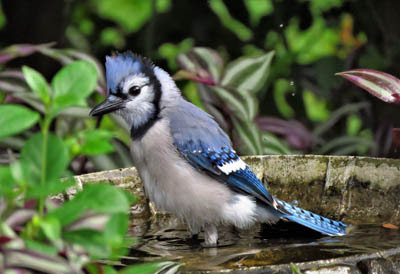 |
| Blue Jay Image by skeeze from Pixabay |
Blue Jays are year-round residents throughout New York.
Blue above with a crest, white below with a black necklace. The wings and tail are barred with black and have white patches. The bill is long and strong.
Calls include a raspy jay jay jay and a whistled wheedle-eedle.
Jays love sunflower seeds and peanuts. They eat from hopper and platform feeders.
Blue Jays are not universally welcome at the feeder. Jays are often aggressive toward other birds and can eat a lot of seed. They frequently carry off a gullet-full of sunflower seeds to go bury in the fall. So some people don’t want to encourage them.
To discourage jays, feed seed in tube feeders and never put out meat or other human food scraps.
Setting up a winter bird feeding station in New York
If you have House Finches, or even forest-loving Purple Finches, visiting your feeders regularly, you may want a tube feeder with black oil sunflower seeds.
But because there are so many ground-feeding sparrows in New York in winter, you probably want a low platform feeder. This feeder is best filled with cheaper mixed seeds that the sparrows and doves will eat.
And a hopper feeder will keep seeds drier during wet periods of winter. You can feed black oil sunflower seeds or hulled sunflower seeds in these.
If squirrels are a problem then a hopper feeder with safflower seeds may attract Northern Cardinals and deter squirrels. Please note that different people have much different results with safflower seeds. Some say it works great. Others say that the cardinals don’t eat it or the squirrels do. It may be worth a try before you spend big on a “squirrel-proof” bird feeder that may or may not work as advertised.
To protect from rain and snow, your bird feeders should have large, maybe even over-sized, roofs to keep out the weather.
Birds in winter need water. Especially do birds need drinking water during several days of below-freezing weather. Since this is a regular occurrence in many parts of New York, a bird bath with heater should be on your list of necessities for winter bird feeding.
Wrapping Up
Winter can be a tough time for our feathered friends. As well as providing food for them when it becomes scarcer, you can help them n other ways:
- set up heated bird baths or ice-free drinkers to ensure birds have access to fresh water for drinking and preening.
- put up nest boxes in the fall, allowing birds to get accustomed to their location before nesting season in spring.
- plant trees and shrubs that provide natural cover and nesting sites.
- keep pets indoors or on leashes to avoid disturbing or harming birds.
- avoid using pesticides and herbicides that could harm birds and their food sources.
- keep windows clean and add feeders close to windows to prevent window collisions.
- rake leaves into loose piles to create attractive foraging areas for ground-feeders.
- participate in citizen science projects like the National Audubon Society’s Christmas Bird Count to help researchers track bird populations and wintering ranges.
Frequently Asked Questions
Are birds out in the winter in NY?
Yes, many birds are out and about in New York during the winter months! While some bird species migrate to warmer climates for the winter, many brave the cold and stay put, taking advantage of the unique food sources and quieter atmosphere that winter brings.
Here are some of the most common winter birds you might see in New York:
- Black-capped Chickadee: These cheerful little song birds with their ” chick-a-dee-dee” calls are frequent visitors to feeders and parks. Chickadees are well- adapted to the cold, with thick downy underfeathers and the ability to go into a short-term hibernation state called torpor to conserve energy.
- Northern Cardinal: A flash of bright red against the snowy landscape, the Northern Cardinal is a beautiful sight in winter. Male Cardinals sing their melodious songs throughout the winter, hoping to attract mates.
- Blue Jay: these striking blue birds with their white bellies and bold personalities are intelligent and vocal. They often form large flocks in the winter, adding a burst of color to the trees.
- Dark-eyed Junco: These ground- feeding birds with their slate- coloredbacks and white bellies are common winter visitors. Look for them hopping around near open areas or under feeders.
- Downy Woodpecker: these small woodpeckers with their black- and white plumage are constantly drumming on trees in search of insects. Woodpeckers have a specialized tongue that can extend far out of their bill to reach insects hidden deep within tree bark.
In addition to these common birds, you might also see American Goldfinch, White- breasted Nuthatch, Mourning Dove, and Canada Geese in New York during the winter.
If you’re interested in winter birdwatching in New York, there are many great places to go. Some of the best spots include Central Park, Prospect Park, Van Courtlandt Park, and the Staten Island Greenbelt.
Do pigeons leave New York in winter?
Contrary to popular belief, pigeons actually do not leave New York in the winter! They’re remarkably good at adapting to the colder temperatures and, in fact, winter can be one of the seasons where their population increases. Here’s why:
Fewer Predators: With many other bird species migrating south, predators like hawks and owls have fewer options for prey, leaving pigeons safer to roam the city.
Abundant Food Sources: Although less accessible, food sources like discarded food, crumbs, and trash are still plentiful in the city even during winter. Pigeons are resourceful scavengers and can still find enough to sustain themselves.
Shelter Opportunities: Cities offer plenty of warm and sheltered locations for pigeons to escape the wind and snow. They can huddle in building nooks, crawl spaces, and under ledges, staying out of the harshest elements.
Physiological Adaptations: Pigeons have natural adaptations like increased feather density and the ability to conserve body heat by restricting blood flow to their extremities, helping them tolerate colder temperatures.
Where do pigeons go at night NYC?
New York City’s pigeons don’t have fancy winter homes, but they’ve mastered the art of finding cozy nighttime accommodations throughout the year. Here are some of their go-to spots:
1. Architectural Hideaways:
- Ledges and Nooks: Building ledges, particularly those under overhangs or awnings, provide sheltered perches with protection from wind and rain. Some pigeons even claim chimneys as their private roosts.
- Windowsills and Rooftops: Wide windowsills and flat rooftops offer spacious, open-air roosting places, especially popular in warmer nights.
2. Urban Jungle Gyms:
- Bridges and Tunnels: The steel framework of bridges and tunnels offers secure nooks and crannies away from predators and harsh weather.
- Statues and Monuments: Gargoyles, ornamental arches, and even the outstretched arms of iconic statues provide sheltered perches with a touch of grandeur.
3. Hidden Corners of Humanity:
- Abandoned Buildings: Empty warehouses and derelict structures offer ample space and protection from the elements, creating temporary pigeon rookeries.
- Subway Grates and Vents: Steam grates and air vents provide warmth and shelter, especially attractive on frigid nights.
4. Parks and Green Spaces:
- Dense Trees and Shrubberies: The thick foliage of trees and shrubs offer protection from wind and predators, particularly when nestled close to buildings for added warmth.
- Underneath Bridges and Overpasses: The sheltered spaces beneath bridges and overpasses offer both darkness and security.
Related Articles should answer your questions on setting up a bird feeder and get you started viewing and identifying your backyard birds:
The most common backyard birds in New York
Birds at your feeder in New York
Red, Orange & Yellow Birds in New York






